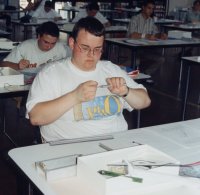
| Thinking... |
IPHO '99 NEWS
- July, 23, 1999 -
Supplement to the n.3 of "La Fisica nella Scuola"
Managing Director: Luigi Brasini
Today, “Tagliatelle” and “Gnocchi” for the lunch at the “Piovego” canteen. We wait for the students sit, to do some interviews. They arrive very slowly, after many hours, about 6, spent on the theoretical exam.
We ask something about the food, and most of them answer they like Italian food. Mindaugas Gedvilas, from Lithuania, says the food and drinks are very different from their’s.

|
|
|
|
Liene Virse is one of the few girls present at this Olypiad, so we ask her why the woman are a minority. “Because Physics is a men’s science” she answers smiling. So we have thought Liene is an exception! Instead a Georgian girl, Lali Tchelidze, who took part also at the last Olympiad in Iceland - the youngest student - regrets there are not many woman. This year the youngest student is an American girl, who studied Physics at school for two and half years, and with some professors at University, she prepared herself at Olympiad.
In general it seems that the students either train alone or are helped by University professors. Infact at school students study Phisics for two - seven years, but for training at Olympiad they add one, like Amit Agarwac, from India, or three mounths like Tawan Sinchai.
In general the students prefer the theoretical exam at the Olympiad, while Liene Virse and his group of students likes the pratical exam.
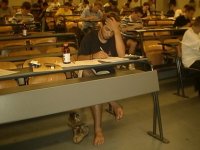
|
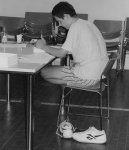
|
|
|
||
The organisation is good for everyone, so for example Patrick Strasser, who has choosen the Olympiad (and the heat of Italy) instead of beach and sea, doesn’t regret his decisioin (but he would have had a nice swim!). In this way everyone was enjoyed their time here in Italy, and someone tells us that our country is a dream.
Finally they go out and we can see a multicolor group that plays freesby on the meadow. Infact it isn’t so hard to comunicate in English or in German. But there are also those who can’t speak very well, so there are some problems, like the Thailandian group who are trying very hard.
At the end, about 3 pm, they seem tired. Someone lays on the meadow and sleeps. Perhaps, in the afternoon they will finally have a rest.
by Rita Serafini & Elena Govoni
When antiprotons are stopped into a H2 target they form ![]() atoms and eventually annihilate.
atoms and eventually annihilate. ![]() annihilations produce various types of events where are present charged pions and kaons (which are directly observable as tracks in an imaging detector surrounding the target), gamma rays and neutral pions and kaons.
annihilations produce various types of events where are present charged pions and kaons (which are directly observable as tracks in an imaging detector surrounding the target), gamma rays and neutral pions and kaons.
Pions are transmitters of the strong force which keeps protons and neutrons bound together to form nuclei.
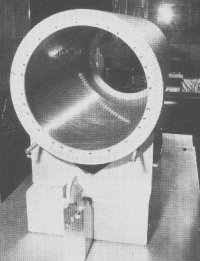 At a more fundamental level the strong force acts between the quarks which constitute protons and neutrons.
At a more fundamental level the strong force acts between the quarks which constitute protons and neutrons.
The transmitters of the strong force between quarks (and between quarks and antiquarks) are called gluons. They are particles without electric charge, which are exchanged between e.g. the three quarks which constitute a proton, and are supposed to keep them bound together in a stable structure. A key characteristic of gluons is that they have (like quarks) a charge of the strong force (called colour). The colour charge of the strong force is the equivalent of the electric charge of the electromagnetic force.
In most of the annihilations, a part of the pions (and/or kaons) are generated from the decay of structures produced directly in the annihilation reaction. Most of these structures (called resonances) are bound states of a quark and an antiquark pair (![]() ) and live very shortly because of the strong interaction at the quark level.
) and live very shortly because of the strong interaction at the quark level.
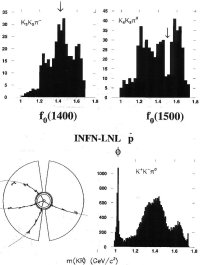 Because of the colour charge two gluons can attract each other and form bound states with zero total colour charge. These bound gluon-gluon (gg) states are called glueballs and can be produced in
Because of the colour charge two gluons can attract each other and form bound states with zero total colour charge. These bound gluon-gluon (gg) states are called glueballs and can be produced in ![]() annihilations (like the
annihilations (like the ![]() meson states) and decay into pions or kaons detectable by the experimental apparatus. The observation of glueballs would represent a major experimental test of the modern theory of strong interactions and has been one of the main goals of experiments with low energy antiprotons in the last 20 years.
meson states) and decay into pions or kaons detectable by the experimental apparatus. The observation of glueballs would represent a major experimental test of the modern theory of strong interactions and has been one of the main goals of experiments with low energy antiprotons in the last 20 years.
The ![]() group of Legnaro has partecipated to an experiment at CERN at the LEAR decelerator which has terminated data taking, is continuing analysis of the collected data and is performing a comparative analysis of data produced by several experiments with stopping antiprotons. A major recent result of this work is the clear identification of the existence of two structures which decay into a kaon and an antikaon, and are likely to have both
group of Legnaro has partecipated to an experiment at CERN at the LEAR decelerator which has terminated data taking, is continuing analysis of the collected data and is performing a comparative analysis of data produced by several experiments with stopping antiprotons. A major recent result of this work is the clear identification of the existence of two structures which decay into a kaon and an antikaon, and are likely to have both ![]() and gg components.
and gg components.
One of the pictures shows a ![]() annihilation event in a H2 target as seen by the vertex detector SPC constructed at LNL and operated at CERN. The tracks of charged pions produced in the annihilation are visualized by the detector. The other pictures show hystograms of the invariant mass of
annihilation event in a H2 target as seen by the vertex detector SPC constructed at LNL and operated at CERN. The tracks of charged pions produced in the annihilation are visualized by the detector. The other pictures show hystograms of the invariant mass of ![]() pairs produced in pp and pn annihilations at rest into different
pairs produced in pp and pn annihilations at rest into different ![]()
![]() (final states. These data are studied and compared to perform what is called an isospin analysis. Spikes or valleys in the spectra indicate the existence of mesons (
(final states. These data are studied and compared to perform what is called an isospin analysis. Spikes or valleys in the spectra indicate the existence of mesons (![]() and/or gg) which decay into a
and/or gg) which decay into a ![]() pair. In the course of the visit explanations will be given about the experiments, the processing of the data and the physics interest, outcome and prospects.
pair. In the course of the visit explanations will be given about the experiments, the processing of the data and the physics interest, outcome and prospects.
By INFN National Laboratory of Legnaro
A spaceborne particle physics experiment has come up with new information on the distribution of cosmic-ray particles. On 2-12 June 1998, the primary payload of NASA's Space Shuttle Discovery in orbit, 400 km above the Earth, was the Alpha Magnetic Spectrometer (AMS, see figure), a sophisticated detector of the type that is normally used in high-energy physics laboratories.
During the 10 day voyage, the AMS recorded the tracks of millions of cosmic particles. It was the first time that such a sophisticated physics detector had been deployed in space and the first time so much information on cosmic particles had been collected. After careful analysis, the data now reveals that nuclear particles in outer space behave in unexpected ways, especially in how they react to the variation of the Earth's magnetic field with latitude. They behave as though they are confined in a large magnetic toroid around the Earth's equator.
Outer space is filled with cosmic-ray particles, the debris being released by subnuclear explosions in distant stars. Viewing these particles from the Earth is difficult because of the shield of the Earth's atmosphere (the particles are transformed as they crash into atmospheric nuclei).
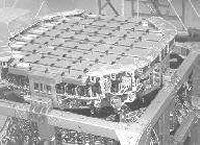 With the AMS, for the first time a major physics experiment was able to view cosmic rays above this atmospheric barrier. The particle tracks recorded by the AMS show how different cosmic particles respond to the magnetic field of the Earth. In orbit, the AMS was able to scan cosmic rays arriving at different latitudes as the Earth moved. According to previous mappings, this magnetic field was expected to repel less energetic particles arriving around the equator. This terrestrial magnetic repulsion becomes weaker at higher latitudes, so that more particles of lower energy would be seen nearer the North Pole and South Pole.
With the AMS, for the first time a major physics experiment was able to view cosmic rays above this atmospheric barrier. The particle tracks recorded by the AMS show how different cosmic particles respond to the magnetic field of the Earth. In orbit, the AMS was able to scan cosmic rays arriving at different latitudes as the Earth moved. According to previous mappings, this magnetic field was expected to repel less energetic particles arriving around the equator. This terrestrial magnetic repulsion becomes weaker at higher latitudes, so that more particles of lower energy would be seen nearer the North Pole and South Pole.
From the recorded data, the AMS finds an unexpectedly high level of lower energy protons at almost all altitudes, and particularly near the equator. This first deployment of an experiment equipped with a powerful magnet above the
Earth's atmosphere reveals that the distribution of cosmic particles 400 km above the Earth is more complex than had previously been thought. Even more surprising is that, for protons at less than 6 GeV and in an equatorial arc extending over 4000 km at an altitude of 400 km, the AMS detector sees as many particles moving upwards (away from the Earth) as coming down. It is as though, at this energy, cosmic protons are constrained around the Earth inside a magnetic toroid. A similar effect is seen with cosmic electrons and their antiparticles - positrons - except here the energy is approximately 3 GeV. These electrons and positrons are also not primordial - they are continuously produced by high-energy cosmic radiation. This should produce as many cosmic positrons as electrons.
However, in the equatorial band, the AMS sees about four times as many positrons as electrons! This discrepancy is not understood. Another puzzle is that in the equatorial toroid, AMS also finds the rare isotope helium-3 rather than the more common helium-4. The advertised goal of the AMS was to search for signs of cosmic antimatter. In a universe created from a Big Bang that presumably created matter and antimatter in equal amounts, there should be signs of this primordial antimatter, with antinuclei built of antiprotons and antineutrons. However, our universe appears to be built up entirely of matter and no experiment has ever detected any primordial antimatter. The AMS set out to look for antinuclei above the screen of the atmosphere, but a sample of almost three million cosmic helium nuclei arriving from outer space revealed not one helium antinucleus. AMS sees no primordial antimatter so far. To reach thousand time more sensitivity we will have to wait for its next mission, for three years on the International Space Station, planned for 2004.
By Roberto Battiston
The greatest discoveries in the field of Sience - at least up to the earliest years of our century - have been made possible with the simplest instruments and tools, and their results were mostly obtained inside small " garage-workshops": think of Millikan's room, set up in the kitchen, or of Fizeau's machine for the measure of c, partly built using waste pieces taken from a clockmaker. What doesn't certainly show up by the typical prints of the 19th century of these great scientists at work in their study, are dozens (or hundreds) of hours spent to elaborate data, to draw up temporary graphics or momentary assessments, before getting (scrupolously pen-and-ink written) the few fundamental sheets that would be left to History.
In the small laboratory of a " High school " or of the biennium in a university, you have the chance to go through the pioneering years of Physics. Anybody knows that F=ma, but how many people have personally and really experimented it, studying even the causes of error and the imperfections of the experimental apparatus? Today this is possible by using well built equipments, often inspired to the original drawings, but realized with modern technologies and materials. Moreover, in the data collection and analysis, we have a powerful allied that would have certainly been used by Galileo and Michelson, if they had had it: the computer. It is useful not only to make calculations- this would be a really modest step forward compared with the pocket calculator-but above all to store the data directly, thanks to special sensors, an interface and obviously the appropriate software, that would also allow an efficient analysis of these data The computer can record for you temperatures, strengths, distances, speed, accelerations, and even the ion concentration or the quantity of dissolved oxygen present in your aquarium.
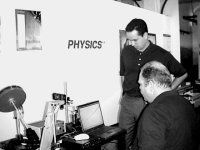
Its advantages in the data analysis and collection are very many. Among them we can mention:
* Accuracy: the sensors are precise, extremely repeatable, strong and reliable.
* Rapidity of execution: the results appear on the screen just few instants after the end of the experiment. Therefore, there is more time left to find out what would happen by varying the conditions of the experiment, and, above all, there is more time to think about and to understand the deepest meanings of the experiment results : what is there ' beneath the surface? ' Also for the teacher, the rapidity of execution is very important : he can have more time for his explanations and for the student's questions. After all, we can definitely say that 300 years of Phisics can be performed in a handful of minutes!!
* Speed (or... patience, according tothe case!). The computer can perform thousands of measures per second, or go on days and days making one measure per minute. Meanwhile you can do something that he can't do: you think.... and understand.
In general the use of a powerful instrument stimulates and gets students curious : they can try out different configurations of the same experiment; observe, and then try and try again. In other words, they can really do experiments.
Nevertheless, the most precious teaching given by the laboratory is that measurements are not easy. Who has at least ' a little ' interest in Science should have to know that behind a simple number representing a result there is precision, attention, method. The experiments come perfect only in simulations or on the blackboard. In the real world, in which friction exists, plates bend, conditions change, it is different! If you want to visit us during the Physics Olympiad, by the space Elitalia PASCO, we will be happy to show you different equipments and some experiments . We also hope to succeed in rousing your curiosity and in entertaining you, because curiosity is also the " basic mainspring" for any physician, and, using the proper means, any experiment can be stimulating.
We wait for you
by Elitalia PASCO
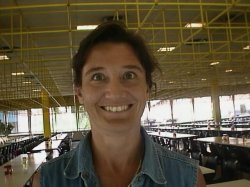
|
Special Thanks! to Dr. Flamini |
| canteen Manager ESU Padua for the availability, the courtesy and the big interest in our problem. |
SMILING...
Where is Turkmenistan?
Not in my residence!